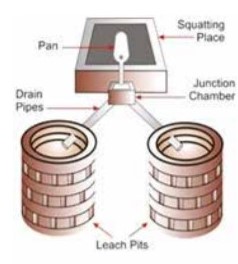World Toilet Day
World Toilet Day
19th November 2021
“Cleanliness is next to Godliness”
A brief….
Toilet Day is declared as official UN Day by United Nations in 2013 in UN General Assembly and celebrated on 19th November of every year. It is intended to inform, engage and inspire people for hygienic sanitation practices. Access to a safe functioning toilet makes positive impact on social well-being and environmental quality. This results in good public health.
![]() Swachha Bharat Mission - Year 2014
Swachha Bharat Mission - Year 2014
The mission aimed to achieve an "open-defecation free" (ODF) India by 2 October 2019, the 150th anniversary of the birth of Mahatma Gandhi through construction of toilets. As part of the campaign, volunteers, known as Swachhagrahis, or "Ambassadors of cleanliness", promoted the construction of toilets using a popular method called Community-Led Total Sanitation.
The mission is
scheduled in two phases.
Phase 1 - Swachh Bharat Mission lasted till October 2019.
The first phase of the mission also included
- Eradication of manual scavenging,
- Generating awareness and bringing about a behavioural change regarding sanitation practices,
- Augmentation of capacity at the local level.
An estimated 89.9 million toilets were built in this period nationwide.
Phase 2 - To help cement the work of Phase 1 between 2020–21 and 2024–25
The second phase of the mission aims to sustain the open defecation free status and improve the management of solid and liquid waste, while also working to improve the lives of sanitation workers. The mission is aimed at progressing towards target 6.2 of the Sustainable Development Goals Number 6 established by the United Nations in 2015.
The mission was split into two: Rural
and Urban.
Nodal Ministry – The ministry
responsible for implementation and monitoring of the mission)
|
SBM
Grameen (Rural Areas) https://swachhbharatmission.gov.in/sbmcms/index.htm
|
|
|
|
|
|
Key Features ·
Elimination of open defecation ·
One toilet for one household ·
Twin Pit Toilet Technology ·
Financial aid of Rs. 12000/-
per toilet to poor, underprivileged and marginalized sector. ·
Women participation in
construction and campaigning. ·
Attainment of Sustainable
Development Goal (SDG) 6.2 – Sanitation for all
|
|
|
||
|
Twin Pit Toilet Technology |
|
|
|
For rural areas, the twin pit toilet is an easy, and economic
toilet option. In this technology, two pits are dug closes to the toilet. These
pits are used alternatively when are gets filled. Under the system, there are
two pits which are used alternately. Both pits are connected with a junction
chamber at one end. Pit walls have a honeycomb structure. The bottom of the
pit is not plastered and is earthen. Depending on the number of users of
toilet, size of the pit varies. Capacity of each pit is normally kept for
three years. First pit, after it gets filled up in about three years, is
blocked at the junction chamber and second pit is put in operation. The
watery part of excreta percolates in soil through the honey comb structure.
After two years of blockage of the first pit, its contents degrade completely
and turn to solid, odourless, pathogen free manure. It is dug out by
beneficiaries and used for agriculture and horticulture purposes. After the
second pit is filled, it is similarly blocked and the first pit is put in use
again. |
|
| ||||||||||
| ||||||||||
|
|
|
IHHL – Individual Household Latrines
ODF – At any point of the day, not a single person is found
defecating in the open.
ODF+ - At any point of the day, not a single person is found
defecating and/ or urinating in the open, AND all community and public toilets
are functional and well maintained.
ODF++ - At any point of the day, not a single person is found
defecating and/or urinating in the open, all community and public toilets are
functional and well maintained, AND entire faecal sludge/ septage and sewage is
safely managed and treated, with no discharging and/or dumping of untreated
faecal sludge/septage and sewage in drains, water bodies or open areas.
The United Nations General Assembly set 17 Sustainable Development Goals (SDGs) in 2015 intended to be achieved by 2030 by all over the world. All the goals are interlinked and have outcome-oriented targets, means of achieving targets and indicators. These goals are included in UN Resolution called as 2030 Agenda or Agenda 2030.
|
Sustainable
Development Goal 6 (SDG 6): Clean water and Sanitation |
|
Access to Clean Water and Sanitation is a basic human
right. Safe drinking water and hygienic toilets protect human life from
diseases as well as maintain the quality of environment. This ultimately
benefits communities and societies for their economic progress.
SDG 6 has in total 8 targets (6 out-come oriented targets and 2 means of achieving targets) to be achieved and 11 indicators to check the level of the goal.
|
SDG 6: Clean water and Sanitation |
|||
|
Target |
Definition |
Indicator |
|
|
6.1 |
Safe
and affordable drinking water
|
Safely Managed Drinking water Service – Drinking
water from improved water source and free from contamination |
6.1.1 - Proportion of
population using safely managed drinking water services |
|
6.2 |
End Open Defecation and Provide access to sanitation
and hygiene |
Use of improved facilities that are not shared with other households and where excreta are safely disposed of in situ or transported and treated offsite Improved sanitation
facilities are those designed to hygienically separate excreta from human contact |
6.2.1 - Proportion of
population using (a) safely managed sanitation services and (b) a hand-washing
facility with soap and water |
|
6.3 |
Improve
water quality, wastewater treatment and safe reuse
|
Improve water quality by reducing pollution, eliminating dumping and minimizing release of hazardous chemicals and materials, halving the proportion of untreated wastewater and substantially increasing recycling and safe reuse globally". (This is also a
sanitation-related target, as wastewater treatment is part of sanitation) |
6.3.1: Proportion of domestic and industrial wastewater flows
safely treated 6.3.2: Proportion of bodies of
water with good ambient water quality |
|
6.4 |
Increase water-use efficiency and ensure fresh water
supplies |
Substantially increase water-use efficiency across all sectors and ensure sustainable withdrawals and supply of freshwater to address water scarcity and substantially reduce the number of people suffering from water scarcity |
6.4.1: Change in water-use
efficiency over time 6.4.2: Level of water stress:
freshwater withdrawal as a proportion of available freshwater resources |
|
6.5 |
Implement Integrated Water Resource management
(IWRM)
|
Implementation of IWRM at all levels, including through transboundary cooperation as appropriate." |
6.5.1: Degree of integrated
water resources management 6.5.2: Proportion of
transboundary basin area with an operational arrangement for water
cooperation |
|
6.6 |
Protect and restore water-related ecosystems
|
Protect and restore water-related ecosystems, including mountains, forests, wetlands, rivers, aquifers and lakes |
6.6.1 is the "Change in
the extent of water-related ecosystems over time |
|
6.a |
Expand
water and sanitation support to developing countries
|
Expand international
cooperation and capacity-building support to
developing countries in water- and sanitation-related activities and
programs, including water harvesting, desalination, water efficiency, wastewater treatment, recycling and reuse technologies |
6.a.1: Amount of water- and
sanitation-related official development assistance that is part of a government-coordinated spending plan |
|
6.b |
Support
local engagement in water and sanitation management
|
Support and strengthen the
participation of local communities in improving water and sanitation management |
6.b.1: Proportion of local administrative units with established and
operational policies and procedures for participation of local communities in
water and sanitation management |
Target 6.1 and 6.2
generally work together as sufficient
and quality water for washing and pouring/ flushing in toilets.
Target
6.2: End open defecation and provide access to sanitation and hygiene.
By 2030, achieve
access to adequate and equitable sanitation and hygiene for all and end open defecation, paying special
attention to the needs of women and girls and those in vulnerable situations.
This target has
one indicator: Indicator 6.2.1 is the "Proportion of population using
(a) safely managed sanitation services and (b) a hand-washing facility with soap and water”.
The definition of
"safely managed sanitation" service is: "Use of improved
facilities that are not shared with other households and where excreta are
safely disposed of in situ or transported and treated offsite. Improved
sanitation facilities are those designed to hygienically separate excreta from
human contact.
![]() A Success Story of India (Year 2019)
A Success Story of India (Year 2019)
Dashboard - SBM Grameen
Dashboard
- SBM Urban
http://swachhbharaturban.gov.in/dashboard/?id=kmp6me5bzon6v6sh
Swaccha Pledge
I will devote 100 hours per year, that is two hours per week, to
voluntarily work for cleanliness.
I will encourage 100
other persons to take this pledge which I am taking today.
I will endeavor to make them devote their
100 hours for cleanliness.
Pledge to Segregate
I pledge to segregate my (household, shop,
establishment) waste in two dustbins, wet waste in Green and dry waste in Blue,
as my contribution to the Swachh Bharat Mission.
He
who is truly clean within, cannot remain unclean without. - Mahatma Gandhi
Ar. Aditi V. Sontakke
Associate Professor,
TSAP.
For any details contact us
Website: www.tsapmumbai.in
E-mail: tsap@thakureducation.org
Contact: 022-67308001/02
Whatsapp: +91-9833665446















Great Project by one of the best school of architectures.
ReplyDelete